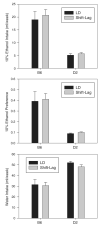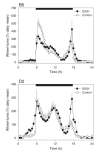Chronobiology of alcohol: studies in C57BL/6J and DBA/2J inbred mice
- PMID: 23313401
- PMCID: PMC3760341
- DOI: 10.1016/j.physbeh.2013.01.001
Chronobiology of alcohol: studies in C57BL/6J and DBA/2J inbred mice
Abstract
Human alcoholics display dramatic disruptions of circadian rhythms that may contribute to the maintenance of excessive drinking, thus creating a vicious cycle. While clinical studies cannot establish direct causal mechanisms, recent animal experiments have revealed bidirectional interactions between circadian rhythms and ethanol intake, suggesting that the chronobiological disruptions seen in human alcoholics are mediated in part by alterations in circadian pacemaker function. The present study was designed to further explore these interactions using C57BL/6J (B6) and DBA/2J (D2) inbred mice, two widely employed strains differing in both circadian and alcohol-related phenotypes. Mice were maintained in running-wheel cages with or without free-choice access to ethanol and exposed to a variety of lighting regimens, including standard light-dark cycles, constant darkness, constant light, and a "shift-lag" schedule consisting of repeated light-dark phase shifts. Relative to the standard light-dark cycle, B6 mice showed reduced ethanol intake in both constant darkness and constant light, while D2 mice showed reduced ethanol intake only in constant darkness. In contrast, shift-lag lighting failed to affect ethanol intake in either strain. Access to ethanol altered daily activity patterns in both B6 and D2 mice, and increased activity levels in D2 mice, but had no effects on other circadian parameters. Thus, the overall pattern of results was broadly similar in both strains, and consistent with previous observations that chronic ethanol intake alters circadian activity patterns while environmental perturbation of circadian rhythms modulates voluntary ethanol intake. These results suggest that circadian-based interventions may prove useful in the management of alcohol use disorders.
Copyright © 2013 Elsevier Inc. All rights reserved.
Figures







Similar articles
-
Chronic ethanol intake alters circadian phase shifting and free-running period in mice.J Biol Rhythms. 2009 Aug;24(4):304-12. doi: 10.1177/0748730409338449. J Biol Rhythms. 2009. PMID: 19625732 Free PMC article.
-
Effects of repeated light-dark phase shifts on voluntary ethanol and water intake in male and female Fischer and Lewis rats.Alcohol. 2010 May;44(3):229-37. doi: 10.1016/j.alcohol.2010.03.002. Epub 2010 May 20. Alcohol. 2010. PMID: 20488643
-
Chronic ethanol intake alters circadian period-responses to brief light pulses in rats.Chronobiol Int. 2005;22(2):227-36. doi: 10.1081/cbi-200053496. Chronobiol Int. 2005. PMID: 16021840
-
Chronobiology of ethanol: animal models.Alcohol. 2015 Jun;49(4):311-9. doi: 10.1016/j.alcohol.2015.04.001. Epub 2015 Apr 21. Alcohol. 2015. PMID: 25971539 Review.
-
Chronobiology of alcohol: from chronokinetics to alcohol-related alterations of the circadian system.Chronobiol Int. 2004;21(6):923-35. doi: 10.1081/cbi-200036886. Chronobiol Int. 2004. PMID: 15646239 Review.
Cited by
-
Impaired voluntary wheel running behavior in the unilateral 6-hydroxydopamine rat model of Parkinson's disease.J Korean Neurosurg Soc. 2015 Feb;57(2):82-7. doi: 10.3340/jkns.2015.57.2.82. Epub 2015 Feb 26. J Korean Neurosurg Soc. 2015. PMID: 25733987 Free PMC article.
-
High drinking in the dark mice: a genetic model of drinking to intoxication.Alcohol. 2014 May;48(3):217-23. doi: 10.1016/j.alcohol.2013.10.007. Epub 2013 Nov 15. Alcohol. 2014. PMID: 24360287 Free PMC article. Review.
-
Bmal1 in the striatum influences alcohol intake in a sexually dimorphic manner.Commun Biol. 2021 Oct 26;4(1):1227. doi: 10.1038/s42003-021-02715-9. Commun Biol. 2021. PMID: 34702951 Free PMC article.
-
Circadian activity rhythms and voluntary ethanol intake in male and female ethanol-preferring rats: effects of long-term ethanol access.Alcohol. 2014 Nov;48(7):647-55. doi: 10.1016/j.alcohol.2014.07.010. Epub 2014 Sep 16. Alcohol. 2014. PMID: 25281289 Free PMC article.
-
Circadian rhythms and addiction: mechanistic insights and future directions.Behav Neurosci. 2014 Jun;128(3):387-412. doi: 10.1037/a0036268. Epub 2014 Apr 14. Behav Neurosci. 2014. PMID: 24731209 Free PMC article. Review.
References
-
- Danel T, Touitou Y. Chronobiology of alcohol: from chronokinetics to alcohol-related alterations of the circadian system. Chronobiol Int. 2004;21:923–35. - PubMed
-
- Spanagel R, Rosenwasser AM, Schumann G, Sarkar DK. Alcohol consumption and the body’s biological clock. Alcohol Clin Exp Res. 2005;29:1550–7. - PubMed
-
- Kuhlwein E, Hauger RL, Irwin MR. Abnormal nocturnal melatonin secretion and disordered sleep in abstinent alcoholics. Biol Psychiatry. 2003;54:1437–43. - PubMed
Publication types
MeSH terms
Substances
Grants and funding
LinkOut - more resources
Full Text Sources
Other Literature Sources
Medical

